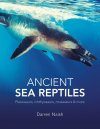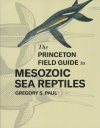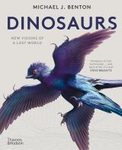By
Leon (NHBS Catalogue Editor)
28 Apr 2023
Written for Hardback

The marine reptiles that roam Earth's oceans today are but a whisper of a once vast and varied group of marine reptiles that included plesiosaurs, ichthyosaurs, and mosasaurs. As palaeontologist Darren Naish shows here, there were many more, less-familiar organisms and the evolutionary history of the group as a whole is fascinating.
Ancient Sea Reptiles is a richly illustrated introduction to their biology and taxonomic diversity that hits the sweet spot when it comes to scientific content, offering a substantive read.
Writing a general book about ancient marine reptiles was long an unrealised passion project for Naish. He mentions the 1997 book
Ancient Marine Reptiles as the most recent work dedicated to them. This overlooks Richard Ellis's
Sea Dragons, but even that dates to 2005, so it was high time. Thanks to the success of his dinosaur book, the London Natural History Museum was willing to take a chance and this personal achievement has now been unlocked. This happened pretty much simultaneously with publication of
The Princeton Field Guide to Mesozoic Sea Reptiles.
The first thing you will notice when you flick through this book is that it is chock-a-block with illustrations: diagrams, family trees, photos of fossils and mounted skeletons, and palaeoart from various artists. These lush production values might deceive you into thinking that this is just so much gift shop fodder (which, do not get me wrong, has its place; I just crave something more substantive). Fortunately, such impressions are wrong as
Ancient Sea Reptiles combines the best of both worlds. Naish has gone to town in giving you a thorough and up-to-date introduction that fully embraces the provisional nature of our knowledge.
The book opens with a chapter that describes the world these organisms inhabited: one in which the seas were not always tropically warm and in which the supercontinent Pangaea, flanked by the Tethys and Panthalassa oceans, was starting to break up, creating seaways. The next two chapters discuss the complex taxonomy of the different groups and their general anatomy. The remaining six chapters cover all the groups: ichthyosaurs, plesiosaurs, mosasaurs, thalattosuchians (sea crocs), sea turtles, and a miscellany of lesser-known early taxa. These chapters introduce the biology as far as it is known, followed by a taxonomical exploration of the major members of each group.
Did I already mention taxonomy? This is the biggest challenge that Naish has to face. Virtually all groups have complicated family relationships, precise placement and origins often remain elusive, convergent evolution seems rife, and many traditional classification schemes have been overturned in the last decade. It is also the book's biggest triumph as
Ancient Sea Reptiles really helped me place into their proper context all the groups that I encountered in other books. Funnily enough, I quoted the description for parvipelvians when reviewing
The Rise of Reptiles, but only now do I understand why this ichthyosaur group is significant. As I want to drive this point home, I will illustrate it with some more examples.
Consider first that, much like whales would later do, marine reptiles evolved from terrestrial ancestors that returned to the sea. But did they do so four times or, as suggested by a recent study that Naish embraces here, just once? The latter option would mean that later groups evolved from marine ancestors. Or consider that plesiosaurs were traditionally divided into long-necked plesiosauroids and short-necked pliosauroids. Until Robert Bakker revived an earlier idea and argued that their history is more complex and involved the repeated evolution of similar body plans. Nowadays, these two names refer to body shapes rather than taxonomic groups. There are also competing ideas about the family tree of thalattosuchians or sea crocs. Today's crocodilians are united in the group Neosuchia which traditionally included thalattosuchians. More recent studies instead place them far removed from neosuchians, meaning that the morphological similarities are yet another case of convergent evolution. And finally, holy smoke, snakes! One group of Cretaceous sea snakes, the pachyophiids, might just be related to the common ancestor of today's snakes, in which case snakes originated in the sea. Or they might not be. The origin of snakes is "among the most debated issues in fossil reptile research" (p. 93).
The above are examples of some fascinating macro-evolutionary patterns. When drilling down into each group, Naish similarly carefully weighs up competing hypotheses. There are one or two places where the discussion gets a touch too technical, e.g. a section on bone margins and articulation surfaces of cymbospondylids that really needs illustrations to be understandable. Overall, however, I much admire how Naish makes this taxonomic tangle accessible, interesting, and relevant.
The book furthermore corrects common misconceptions and outdated ideas. Vintage palaeoart depicts the long-necked plesiosaurs as having extremely flexible necks that were held aloft above water in a swan-like fashion. This was never grounded in fact and current thinking comes down on necks having limited if still impressive mobility. We similarly often think of them as chasing sardine-like fish, but that underrates their predatory abilities. And then there is the controversial idea that mosasaurs were a dead-end group for whom the end-Cretaceous asteroid impact was the final straw. Not so, argues Naish, they were evolving rapidly right up to the K–Pg boundary. Interestingly, this has also been suggested for dinosaurs, where it has attracted similar objections.
Finally, those who know Naish will not be surprised that he considers more speculative ideas in earnest. Did some plesiosaurs have internal nostrils that they used for underwater smelling? Maybe, but if some experts are to be believed, the idea "might be bogus" (p. 44). Did shastasaurs, an ichthyosaur group, catch prey through suction feeding? Naish points out all the anatomical details that do not stack up in favour and rejects the idea. And did mosasaurs beach themselves like orcas to catch prey? "We have no evidence [...] and probably never will, but it remains a viable speculation" (p. 166).
Overall, Naish has every reason to be proud of getting this book published. It packs an impressive amount of accessible scientific information between its covers and is gorgeously illustrated. There is simply no comparable book on the market and this should be your de facto starting point for reading deeper into the evolutionary history and biology of these amazing reptiles.








































